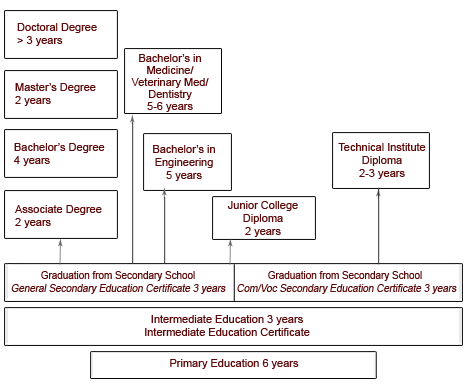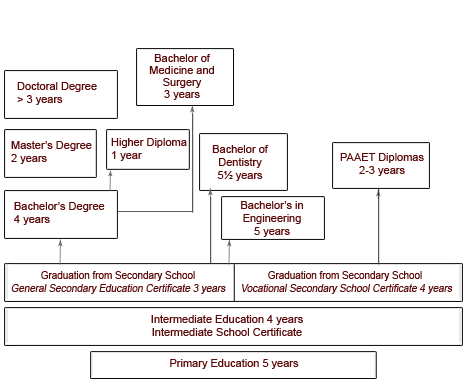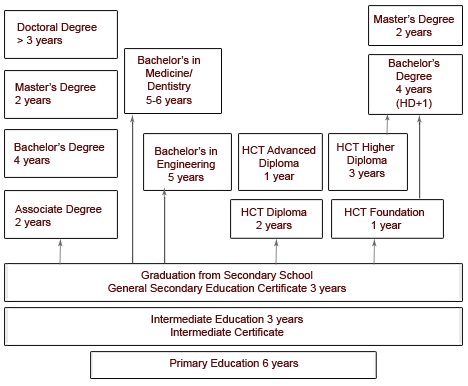Working with Academic Credentials from Saudi Arabia and the Gulf States
By WES Staff
What follows is a quick primer on the academic systems of three states in the Persian Gulf: Saudi Arabia, Kuwait and the United Arab Emirates.
While education authorities in these states are undertaking groundbreaking initiatives at the tertiary level to better train their workforces domestically, a significant and increasing number of students continue to travel to the United States and elsewhere to undertake higher studies. With this movement of Arab students to universities in the United States and beyond, familiarity with education systems in the Gulf is becoming increasingly important for international admissions departments.
Government scholarship programs are covering many of the costs associated with sending Arab students abroad. The hope is that overseas-educated graduates will return home to drive innovation and, perhaps more importantly, train future generations at domestic institutions such as the recently inaugurated King Abdullah University of Science and Technology in Saudi Arabia, which currently is staffed mainly by expatriate academics.
In absolute numbers, the most significant cohort of Arab students in the United States is arriving from Saudi Arabia. The recent explosion in the numbers of Saudi students attending U.S. universities is a direct result of the Saudi Ministry of Higher Education’s King Abdullah Scholarship Program (KASP), which has been sending students to universities in Europe, Asia and North America since its inauguration in 2006. Approximately 17,000 Saudi nationals are joining the program annually, with numbers likely to grow further in the next few years. Since its launch, the number of Saudi students at U.S. universities increased to 12,661 in 2008/09 from 3,448 in 2005/06.
Saudi Cultural Attache to the US, Dr. Mohammad Aleissa, said in 2006 when the scholarship initiative was launched that the program was part of a Saudi initiative in partnership with the then administration of President George W. Bush’s to counter ‘some misunderstandings’ between the United States and Saudi Arabia in the wake of the September 11, 2001 terrorist attacks. Considering the geopolitical importance of this region to the United States, the need for cross-cultural understanding is paramount. One of the most significant ways to achieve this understating is through educational exchange.
In the December issue we will publish an overview of the Iraqi education system to help international admissions departments prepare for a likely increase in the numbers of applicants arriving from Iraq over the next few years. These students will be funded through the government’s recently launched Iraq Scholars and Leaders Program.
For more in-depth opportunities to learn about the education systems of the Gulf region and other countries please see the WES workshop and webinar calendar.
Saudi Arabia
Quick Facts
- Secondary Enrollment: 4.293.300 (2005-2006)
- Tertiary Enrollment: 944,460 (2007-2008)
- Compulsory Education: To Grade 6
- Education Administration and Finance:
- Ministry of National Education (secondary, teacher education)
- Ministry of Higher Education (universities)
- Technical and Vocational Training Corporation (TVTC) (secondary, higher technical institutes, higher commercial institutes). Formerly known as the General Organization for Technical Education and Vocational Training (GOTEVOT)
- Language of Instruction: Arabic
- Academic Year: September to June
- Number of Saudi Students in the US: 9,783 (2007-2008: Open Doors)
- 5,772 at the undergraduate level (25.2% increase from 2006-2007)
- 2,307 at the graduate level
- University and College Listings
Structure of Education
Secondary Education
Upper secondary education is divided into four three-year branches:
- General Academic,
- Religious,
- Vocationa l and Commercial.
The General Academic branch is divided into Scientific and Literary streams.
At the end of their third year, students take the General Secondary Examination administered by the regional Directorates of Education.
Students follow national curricula and examinations are administered and supervised by secondary schools.
Completion of the General Academic branch leads to the General Secondary Education Certificate
| Common Secondary Grading Scale in Saudi Arabia | |
| Grades | WES Conversion |
| 85 – 100 (Very Good) | A |
| 65 – 84 (Good) | B |
| 50 – 64 (Pass) | C |
| 0 – 49 (Fail) | F |
Higher Education
Policy decisions, funding, administration and regulation are guided by the Ministry of Higher Education and the Technical and Vocational Training Corporation.
Types of Institution
- Public universities (18)
- Junior colleges
- Girls’ colleges
- TVTC technical institutes
- Private colleges (supervised by the General Commission for Licensing and Accreditation)
Requirements for Admission to Higher Education
- General Secondary Education Certificate
- Entry to specific programs is based on the secondary stream and the scores acquired in the General Secondary Education Certificate
- Girls’ colleges and junior colleges have less competitive entrance requirements
Degree Framework
- Stage I
- Associate degree (two years)
- Junior College Diploma (two years)
- Technical Institute Diploma (two years)
- Bachelor’s degree (four years)
- Bachelor or Engineering (five years)
- Stage II
- Master’s degree (two years)
- Stage III
- Doctor of Philosophy (three years minimum)
Degree Structure and Grading
Public universities and private colleges award qualifications that must comply with the National Qualifications Framework.
Undergraduate curricula offer a wide range of general education and elective courses along with courses specific to the degree specialization.
Periods of study are quantified in credits, and the academic year is based on semesters. A non-credit foundation, or preparatory, year is offered by most universities.
| Common Higher Education Grading Scales in Saudi Arabia | ||
| Letter Grades | Numeric Grades | WES Conversion |
| A+/A | 5/4.75 | A |
| B+ | 4.5 | A- |
| B | 4 | B+ |
| C+ | 3.5 | B |
| C | 3 | B- |
| D+ | 2.5 | C+ |
| D/SC | 2 | C |
| F | 1 | F |
Additional Resources
Kuwait
Quick Facts
- Secondary Enrollment: 478,000 (2006)
- Tertiary Enrollment: 57,436 (public, 2007)
- Compulsory Education: Grade 9
- Education Administration and Finance:
- Ministry of Education (secondary)
- Ministry of Higher Education (universities)
- Public Authority for Applied Education and Training (PAAET – vocational post-secondary)
- Language of Instruction: Arabic
- Academic Year: September to June
- Number of Kuwaiti Students in the US: 1,823 (2007-2008: Open Doors)
- 1,215 Undergraduate Level
- 447 Graduate Level
Structure of Education
Secondary Education
Upper Secondary education is divided into two branches: General Academic (three years) and Vocational (four years).
In the General Academic branch, students follow a common first-year curriculum and then chose to pursue either the Science stream or the Literature stream.
A credit and a non-credit assessment system lead to the General Secondary School Certificate . The credit system is based on credit accumulation and continuous assessment at the secondary school. The non-credit system is based on final examinations administered by the Ministry of Education.
Completion of the General Academic branch leads to the General Secondary School Certificate .
| Common Secondary Grading Scale in Kuwait | |
| Grades | WES Conversion |
| 4.0 (Excellent) | A |
| 3.0 (Very Good) | B |
| 2.0 (Good) | C |
| 1.0 (Pass) | D |
| 0 (Fail) | F |
Higher Education
Policy decisions, funding, administration and regulations are guided by the Ministry of Higher Education and the Public Authority for Applied Education and Training.
Types of Institution
- Kuwait University (the only public university)
- Private Universities (supervised by the Private Universities Council)
- PAAET Vocational Colleges (4) and Institutes (7)
Requirements for admission to higher education
- General Secondary School Certificate
- Kuwait University faculties may require English and/or mathematics aptitude tests and interviews
- Admission to vocational programs is based on the General Secondary School Certificate
Degree Framework
- Stage I
- Vocational Institute Diploma (two to three years)
- Bachelor’s Degree (four years)
- Bachelor of Engineering (five years)
- Stage II
- Master’s degree (two years)
- Higher Diploma (one year)
- Stage III
- Doctor of Philosophy (three years minimum)
Degree Structure and Grading
Undergraduate curricula comprise a general education component with introductory, advanced and elective courses, coupled with course linked to the degree specialization.
Periods of study are quantified in credits. A four-year degree requires the completion of 120 semester credits. The academic year is organized on a semester basis.
| Common PAAET Grading Scale in Kuwait | |
| Grades | WES Conversion |
| A, 4.0 | A |
| B+, 3.5 | B+ |
| B, 3.0 | B |
| C+, 2.5 | C+ |
| C, 2.0 | C |
| D+, 1.5 | D |
| D, 1.0 | D |
| F, 0.0 | F |
| Common University Grading Scale in Kuwait | |
| Grades | WES Conversion |
| A, 4.0 | A |
| A-, 3.67 | A- |
| B+, 3.33 | B+ |
| B, 3.0 | B |
| B-, 2.67 | B- |
| C+, 2.33 | C+ |
| C, 2.0 | C |
| C-, 1.67 | C- |
| D+, 1.33 | D |
| D, 1.0 | D |
| F, 0.0 | F |
Additional Resources
- System of Education (UNESCO)
United Arab Emirates
Quick Facts
- Secondary Enrollment: 650,000 (2006-2007)
- Tertiary Enrollment: 33,740 (2006)
- Compulsory Education: Grade 9
- Education Administration and Finance:
- Ministry of Education (secondary)
- Ministry of Education and Scientific Research (higher education)
- Language of Instruction: Arabic
- Academic Year: September to June
- Number of UAE Students in the US: 983 (2007-2008)
- 585 Undergraduate Level
- 184 Graduate Level
Structure of Education
Secondary Education
Upper Secondary education is divided in three three-year branches: General Academic , Religious and Vocational.
In the General Academic branch students follow a common first-year curriculum and then chose to pursue either the Arts stream or the Science stream.
A large number of private secondary schools teaching in English cater to the non-UAE population (approximately 75 percent of the country). Most of the private secondary schools follow foreign curricula.
Completion of the General Academic branch leads to the General Secondary School Certificate.
| Common Secondary Grading Scale in the United Arab Emirates | |
| Grading scale | WES Conversion |
| 90-100 | A |
| 80-89 | B+ |
| 70-79 | B |
| 60-69 | C |
| 0-59 | F |
Higher Education
Policy decisions, funding, administration and regulations are guided by the Ministry of Education & Scientific Research.
Private universities and colleges are accredited through the Commission for Academic Accreditation.
Types of Institution
- UAE University and Zayed University (public universities)
- Private Universities and Colleges
- Higher Colleges of Technology
Requirements for Admission to Higher Education
- General Secondary School Certificate
- Nation-wide examination, the Common Educational Proficiency Assessment administered by the National Admissions and Placement Office and the Ministry of Education and Scientific Research
- Other requirements may be English aptitude tests and the foundation year
Degree Framework
- Stage I
- Associate Degree (two years)
- HCT Diploma (two years)
- HCT Advanced Diploma (two years)
- HCT Higher Diploma (three years)
- Bachelor’s Degree (four years)
- Bachelor of Engineering (five years)
- Stage II
- Master’s Degree (two years)
- Stage III
- Doctor of Philosophy (three years minimum)
Degree Structure and Grading
Undergraduate curricula comprise a general education component with core classes in the degree specialization.
Periods of study are quantified in credits. A four-year degree requires the completion of 120 semester credits. The Academic year is organized in a semester basis.
A one-year Foundation course is usually required for admission to Higher Colleges of Technology Higher Diplomas and Bachelor’s programs.
| Common University Grading Scale in in the United Arab Emirates | |
| Grades | WES Conversion |
| A, 4.0 | A |
| A-, 3.67 | A- |
| B+, 3.33 | B+ |
| B, 3.0 | B |
| B-, 2.67 | B- |
| C+, 2.33 | C+ |
| C, 2.0 | C |
| C-, 1.67 | C- |
| D+, 1.33 | D |
| D, 1.0 | D |
| F, 0.0 | F |
| Common HCT Grading Scale in in the United Arab Emirates | |
| Grades | WES Conversion |
| 90-100, A | A |
| 75-89, B | B |
| 60-74, C | C |
| 0-59, F | F |
Additional Resources
Academic Credentials from Saudi Arabia, Kuwait and United Arab Emirates
What institutions provide
- Degree certificates/diplomas
- Academic transcripts
What WES requires
- Academic transcripts from the university attended
- Copy of final degree certificate




